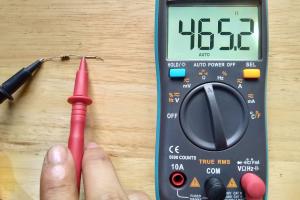Mastering Resistor Testing: The Complete Guide to Using a Multimeter

-
Quick Links:
- Introduction
- Understanding Resistors
- Multimeter Overview
- Preparation for Testing
- Step-by-Step Guide to Testing a Resistor
- Common Issues When Testing Resistors
- Real-World Case Studies
- Expert Insights on Resistor Testing
- Conclusion
- FAQs
Introduction
Testing a resistor is a fundamental skill for anyone involved in electronics, whether you're a seasoned professional or a hobbyist. This comprehensive guide provides a deep dive into the process of testing resistors with a multimeter, complete with detailed steps, expert opinions, and real-world examples. Understanding how to measure resistance accurately not only aids in troubleshooting electronic devices but also enhances your skills in electronics design and repair.
Understanding Resistors
Resistors are passive electronic components that limit the flow of electric current in a circuit. They are characterized by their resistance value, typically measured in ohms (Ω). Here are some key points to understand:
- Types of Resistors: Fixed, variable, and specialty resistors (like thermistors and photoresistors).
- Color Code: Resistors often have color bands that indicate their resistance value.
- Power Rating: Each resistor has a maximum power rating, usually in watts, which should not be exceeded to avoid damage.
Multimeter Overview
A multimeter is an essential tool in electronics, allowing you to measure voltage, current, and resistance. Here’s a closer look:
- Types of Multimeters: Analog vs. digital multimeters, with digital being the more common choice today.
- Functionality: Most multimeters have settings for measuring AC and DC voltage, current, and resistance.
- Features: Advanced multimeters may include features like data logging, Bluetooth connectivity, and auto-ranging.
Preparation for Testing
Before testing a resistor, preparation is key to ensuring accurate readings and safety:
- Gather Your Tools: You will need a multimeter, the resistor you wish to test, and possibly a breadboard or alligator clips.
- Safety First: Ensure that the circuit is powered off and that the capacitor is discharged, if applicable.
- Understanding Settings: Familiarize yourself with your multimeter's settings—set it to the resistance (Ω) mode.
Step-by-Step Guide to Testing a Resistor
Follow these steps to accurately test a resistor using a multimeter:
- Select the Right Multimeter Setting: Turn your multimeter dial to the resistance mode (Ω).
- Connect the Probes: Insert the black probe into the COM port and the red probe into the VΩmA port.
- Prepare the Resistor: If it's in a circuit, desolder it or ensure it is disconnected from power.
- Measure Resistance: Touch the probes to either end of the resistor. Ensure good contact for an accurate reading.
- Read the Value: Observe the multimeter display for the resistance value.
- Compare with Rated Value: Cross-check the measured value with the resistor's color code or specifications.
Common Issues When Testing Resistors
While testing resistors is generally straightforward, several common issues might arise:
- Incorrect Setting: Ensure the multimeter is set to measure resistance.
- Bad Connections: Ensure that the probes are making good contact with the resistor terminals.
- Faulty Resistor: A resistor may be open or shorted, leading to inaccurate readings.
Real-World Case Studies
Understanding how to test resistors can be illustrated through case studies:
Case Study 1: Repairing a TV
A technician diagnosed a malfunctioning TV by testing resistors in the power supply circuit. After identifying a failed resistor, he replaced it, restoring the TV to proper functionality.
Case Study 2: DIY Electronics Project
A hobbyist built a simple LED circuit that wouldn't light up. By testing the resistors in the circuit, he discovered one was incorrectly rated, leading to the circuit's failure. Once replaced with the correct value, the project worked flawlessly.
Expert Insights on Resistor Testing
Insights from industry experts can greatly enhance your understanding of resistor testing:
- Use Quality Multimeters: Experts recommend investing in a quality multimeter for precise measurements.
- Regular Calibration: Regularly calibrate your multimeter for consistent accuracy.
- Documentation: Keep a log of resistor values and measurements for future reference, especially in complex circuits.
Conclusion
Testing a resistor with a multimeter is an essential skill in electronics that can save time and resources. By following the steps outlined in this guide and being aware of common pitfalls, you can ensure accurate measurements and troubleshoot electronic devices effectively.
FAQs
- What is a resistor? A resistor is an electronic component that resists the flow of electric current, measured in ohms.
- How do I know if a resistor is bad? If the measured resistance value is significantly different from the rated value or shows open/shorted conditions, it may be bad.
- Can I test a resistor in-circuit? It is generally recommended to remove the resistor from the circuit for accurate readings.
- What does a multimeter measure? A multimeter measures voltage, current, and resistance.
- Why is my multimeter not giving a reading? Check the connections, settings, and battery of the multimeter.
- What are the common resistance values? Common values include 1Ω, 10Ω, 100Ω, 1kΩ, 10kΩ, and 100kΩ.
- Can resistors fail? Yes, resistors can fail due to overheating, overcurrent, or manufacturing defects.
- What is the difference between a fixed and variable resistor? A fixed resistor has a set resistance value, while a variable resistor can be adjusted.
- How do I read the color code on resistors? The color bands represent numbers; you can find color code charts online for assistance.
- Is it necessary to discharge capacitors before testing? Yes, discharging capacitors helps prevent electric shocks and ensures accurate readings.
Random Reads
- How to install hampton bay ceiling fan
- How to install homebrew on wii u
- How to request new article topic
- How to polish concrete
- How to plunge kitchen bathroom sink
- How to polish acrylic
- How to make fences in minecraft
- How to make google drive folder offline android
- How to install wood stairs
- How to remove vertical blinds